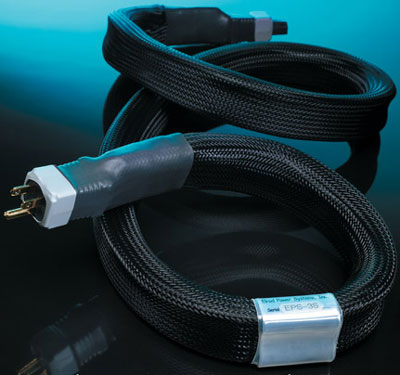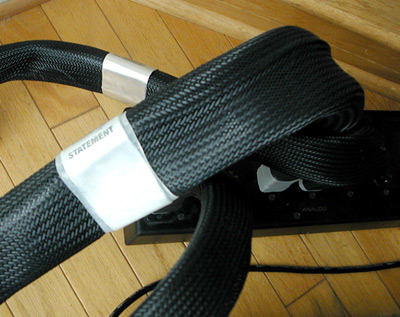You are reading the older HTML site
Positive Feedback ISSUE 9
october/november 2003
elrod power systems
Statement power cords
as reviewed by Bob Neill

BOB NEILL'S SYSTEM: LOUDSPEAKERS ELECTRONICS SOURCE CABLES ACCESSORIES
|
I was not eager to hear David Elrod's relatively new top-of-the-line Statement power cords. I did not feel my system needed more of what I have learned power cords tend to add. I did not want to have to sit here and talk about $2700 cords to an audience made up largely of sane, sensible, and (relatively) frugal folk. But because David's Signatures are so fine, because I have become a ‘professional' listener who has some obligation to cover the territory, and because, as a new Elrod dealer (alert), I have to be able to talk about and sell the damn things, I agreed to give them a listen.
I have now spent about a week with them (they arrived with "around a month of on and off play" on them) and am ready to report out. (I am a quick read.) And the good/bad news is that if you have an amplifier or monoblocks that draw a respectable amount of current, the Statements will very likely make them sound as much as twice as good. Twice as powerful, twice as spacious. Considerably more transparent. And, most noticeable, startlingly more ‘alive.' That is how I have rationalized their continuing presence (and expense) in my house: they are not a separate component, as I have considered after-marker power cords heretofore. They are an absolute amplifier upgrade.
No matter what CD's I put on—Mozart, Stacey Kent, Mahler—the music became more lifelike, more forceful, more expressive, larger, richer; and the whole thing had the ease and confidence we associate with great resources of distortionless power. In direct comparison, my (until now) absolutely satisfying EPS Signatures, while as smooth, eloquent, and as refined ever, seemed like weak sisters. Early on in his assessment of the Statements, David says he felt they sound best in a system that included Sigs; and that is what mine has: Sig 2's on the Audio Note CDT-2 transport, Dac 4.1 balanced, and Blue Circle AG3000; Statements on the AG8000 monoblocks. Recently, having heard a full set of well-broken Statements on an entire system, he confessed that alas, a full set of Statements can be "awesome." I'm sure this is true. But based on my experience with Statements limited to amplification, I am entirely satisfied with this arrangement, letting them come into play at the end of the chain when it's time to bring it all home.
I do not know what Statements would do to lower-powered amps. But I expect, if folks can manage to think of them as amp upgrades rather than ac cords, some 30-100 watt tube amp owners are going to find out. Would a Statement transform a 30-watt Audiomat Arpege or Prelude into what the Solfege dreamed of being? Would a Statement turn the amiable Blue Circle BC24 into a giant killer? And somebody just has to put one on a Berning. I really do think this cord will come to be known as ‘The Realizer': a component that quite literally unleashes the latent powers of amps it is attached to.
To the Music
Mahler Symphony #6, Jansons and the London Symphony Orchestra, LSO Live. Doing an A/B between the Signatures and Statements on this CD, the Sigs seem lighter, the amps lower-powered. The Statements add avoirdupois but also a wonderful spaciousness and expressiveness that result in a considerably more emotional presentation. The orchestra seems smaller on the Sigs. The Statements make it all feel more lifelike. The Sigs are smooth and eloquent. The Statements amplify these qualities, placing them into a larger, more compelling context. The Statements make the Signature presentation seem pale. On the Statements, it is absolutely more Mahlerian—and any reservations one might have about Janson's approach being too light evaporate.
Jackie McLean, Destination Out, Blue Note (1963). Right from the opening notes from Grachan Moncur III's trombone and Larry Ridley's bass, the Statement's greater body and forcefulness give this recording more life. The Statements seem to breathe power into the proceedings—without loss of refinement. The recording sounds as if it were made last year, not 40 years ago—and it has not been remastered. (Thanks must go to my Audio Note dac for this as well.)
A major problem I am having in this audition as it proceeds is taking CD's off the transport. I know that's a cliché but in this case it truly applies. The Statements are making all of the CD's I feed the more compelling, harder to think of as recordings.
CPE Bach, Solo Keyboard Music, Volume 10, Miklos Spanyi clavichord, Bis. A tiny voiced instrument, the clavichord is intended for small rooms, intimate settings. So what in all that is sane have the Statements to contribute here?! Mainly ease and beauty, it turns out. One of the Statement's surprises is what it contributes to the midrange: the kind of eloquence the Audio Note Dac 4.1 provides—a smooth articulateness. On the Signatures, everything is, at first, just as good—but soon not quite as bewitching? Is that it? On the larger cords, the bottom is a little firmer, there is more venue, and the clavichord as a whole is gentler, which was not at all what I expected. The music is a little more like a performance, a little less like an information transfer. On this recording, the difference is not a huge deal, I grant you; but it is an interesting one.
Kenny Drew Trio, Winter Dreams, Milestone Records. The Signatures can seem faster. That's what Bob Hirsch, who has heard more different cables in his life than I will ever hear, initially heard. And the Sigs initially do seem faster on this recording. But shifting to the Statements, the Sigs' speed in retrospect seems to be mainly a relative lack of low-end authority and information: they are lighter. And lighter is not necessarily faster, though it often seems so. The Sigs in an absolute sense are not light. But compared with the Statements, they are light-er. As a result, their low end can seem tighter—probably because there is less there to deal with. But listening to Drew's piano—and then later on Keith Jarrett's on his latest, Up for It on ECM, I could hear how some might be drawn to the positive aspects of this lightness. Piano on the Signatures can sound more lyrical, if also less powerful and less…embodied.
Haydn, Symphonies 17-21. Roy Goodman and The Hanover Band, Hyperion. I listened to this recording mainly to hear if the Statements would overpower the essential delicacy that balances orchestral weight, both of which are attributes of Goodman's fine set of Haydn symphonies—now being re-released by Hyperion at mid-price, by the way. The presentation did sound more vigorous than on the Signatures, but the harpsichord and first violins danced lightly and appealingly over the brass and lower strings, just as they should.
What the Statements are contributing is not the pure testosterone boost or additive that some AC cords are famous for. Listening to the Haydn, this comes through clearly. There is more power, more drive to the performance; but it seems utterly right, not overblown. The larger cords do change the presentation—there is no question about that. But seemingly from inside the music.
JS Bach. Complete Cantatas, Volume 5, Ton Koopman, Erato (being re-released and completed by Challenge). I am very fond of this edition of Bach's cantatas, though I have always considered it a bit reserved and understated, not to say dull. If the Statements need a recording to absolutely make their case, this would be it. Their authority and power breathe added life and enthusiasm into Koopman's forces. And the kerk (Waalse in Amsterdam) is here as I've never heard it before. Voices are rich and clear, the accompanying gamba on BWV 207a is coppery warm but also more vitally present than it's been before. Bob Hirsh picked this up in the viola on a string quartet recording he was listening to just this week: "Last night, through the Statement [on his Blue Circle BC28], the viola finally come across with that slightly hollow resonance that is so hard to convey convincingly. Each instrument in the quartet stood out so clearly but without any spotlighting. It wasn't about increased clarity either, it's hard to describe. Playing sounded more inspired, closer to hearing THE performance as opposed to one of the many."
Mozart, Piano Concertos #24 and 25, van Immerseel, forte piano, Animal Eterna orchestra, Channel Classics. What the Statements bring to my favorite set of the Mozart piano concertos is added dynamics and weight, weight that lets the double basses have their proper say and, wonderful surprise, lets a clarinet sound richer. I had always considered this recording a little lighter than I want it. With the Statements, it is just right. The grace and fleetness that gives this version its distinctiveness is intact. But now we have a real orchestra in the room!
Stacey Kent, Close Your Eyes, Candid Records. Thank you, Backwoods Ontario Barry, for introducing me to Stacey Kent. This is the jazz singer many have mistaken Nora Jones for. When and if Ms. Kent finds the larger audience she deserves, Ms. Jones will come to seem like the charming shooting star she is. The Statements add just that degree of body and energy that gets Kent into the room and makes nothing else seem to matter. Spectacular.
Final Words
Okay, that's about it. These cords are what we should have expected from David Elrod, whether we wanted that or not! They are large—nearly twice the diameter of the Signatures to make room for the larger ribbons used in the Statements. Being large, they are somewhat of a pain in the petoot to manipulate, though they will take the full 90 degree bend near the ends to accommodate cramped space requirements. I am told they take a "couple of months" to break in (DE). Again, my samples had a good deal of time on them when they arrived. They are expensive, prohibitively so for many, unless they are, as I have rationalized, considered a part of your amplifier. A whole system full of Statements is a project for the very few and the very well-to-do.
All of this said, they are significantly better than the Signatures in fundamentally musical ways, unless you are addicted to relative lightness and lyricism in all things. Like the rest of my system as it has evolved over the past year or so, they move the presentation away from being charmingly and even eloquently about the music toward simply being the music. As we know, though we often say differently, not everyone wants that. An awful lot of audiophiles—unbeknownst to themselves, of course—are closet Platonists, yes? But until you actually hear a system take a giant step toward the thing itself, you really don't know what high-end audio is capable of. With the Statements in our house over the past week, I have been dragged out of the closet and made to face that. It has been an extraordinary experience, which makes me grateful to the gods, David Elrod, and my editors for making it possible.
And now somebody—please somebody—audition one on a lower-powered tube amp. We really need to know what they can do there.

EPS Statement in foregound, EPS Signature in the
background.
Elrod Statement Cords
Retail: $2700 for either a 5 or 6-foot cord.
Elrod Power Systems
716 Fair Forest Drive
Greenwood, SC 29646
TEL: 864. 227. 9107
email address: [email protected]
Bob Neill is a part-time dealer for Elrod Power Systems, Blue Circle, Audience, TG Audio, and JM Reynaud.
